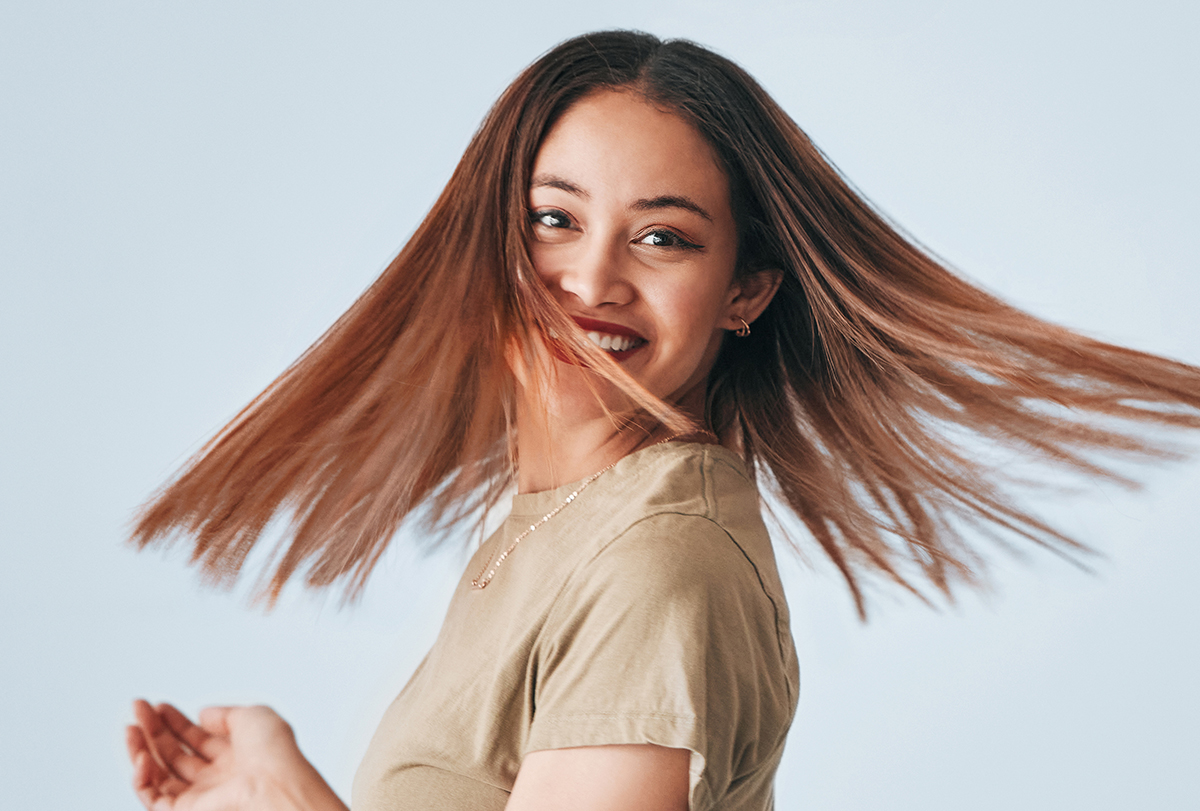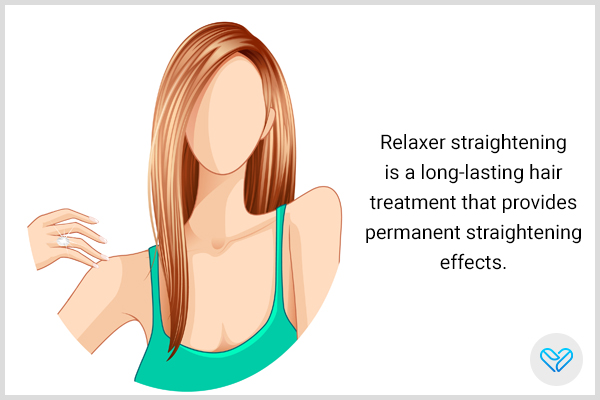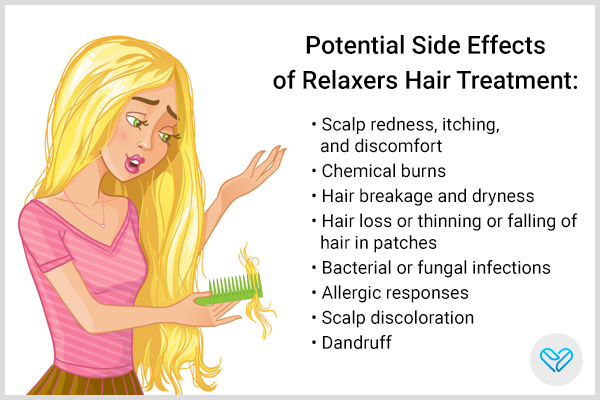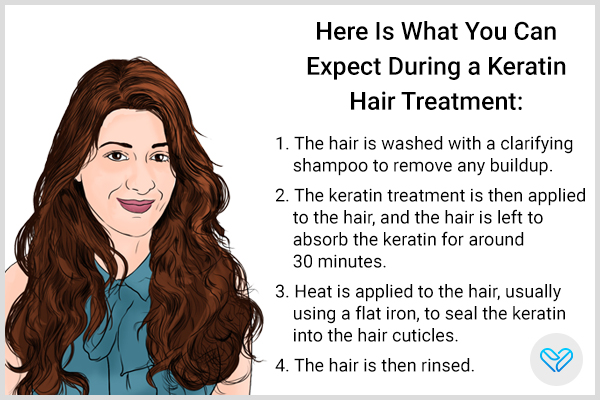In this article:
From celebrities to influencers, a lot of people are talking about hair care products and treatments.

This newfound frenzy for hair treatments has paved the way for the development of more and more options, two of which include relaxers and keratin treatments.
Relaxer and keratin treatments aim to transform the texture and appearance of your hair, but they work in different ways and therefore have different uses.
Relaxers are chemical treatments that alter the structure of the hair, specifically targeting the natural curls to result in much straighter hair. It is often used by individuals with tightly coiled or curly hair who desire a smoother, more manageable style. (1)
On the other hand, keratin treatments are smoothing treatments that infuse the hair with keratin, a protein naturally found in the hair. It helps to enhance shine and color, reduce frizz, and make curly hair more manageable. (2)(3)
If you want to permanently straighten your very curly hair, a relaxer treatment may be more suitable. However, if you are looking to reduce frizz and improve manageability, a keratin treatment would be a better option.
If you still find yourself wondering which one is better for you, keep reading to dig a little deeper into the two.
What to Choose: Relaxer Treatment or Keratin Treatment?
| Factors | Keratin Treatment | Relaxer Treatment |
|---|---|---|
| Main purpose | Smooth, straighten, and reduce frizz in the hair | Permanently alter hair texture to make hair straight |
| Main ingredients | Keratin protein, amino acids | Chemicals such as sodium hydroxide and ammonium thioglycolate |
| Issues targeted | Frizz, dryness, and damage | Curly and coily hair |
| Suitability for hair type | Suitable for most hair types | Primarily suitable for textured or tightly curled hair types |
| Mechanism of action | Fills gaps in the hair shaft | Breaks disulfide bonds in the hair to change its structure |
| Frequency of use | Every few months or as needed | Every 6-8 weeks or as required |
| Potential side effects | Minimal side effects | Scalp irritation, hair breakage, dryness |
Consider these factors when deciding which product is made for you.
Permanent hair straightening

If you have naturally curly or tightly coiled hair and want to achieve straighter hair, a relaxer treatment may be more suitable.
Hair relaxers are widely used to achieve straighter and more manageable hair. These products have been on the market for several decades, offering a convenient solution for individuals seeking a change in their hair texture. (4)
Hair relaxers typically contain strong alkaline substances, such as sodium hydroxide and lithium hydroxide, which work by chemically breaking down the protein bonds in the hair, permanently altering its structure and creating a straightened effect.
The entire straightening process usually takes around 20-25 minutes. (4)
Note: It’s important to note that alkaline relaxers are potent and can cause damage if not used correctly. Overprocessing the hair with a relaxer can lead to irreversible damage to the keratin structure, resulting in hair breakage.
Frizz reduction and increased manageability
If you simply want to reduce frizz, enhance shine, and improve manageability while maintaining some level of curl or wave, a keratin treatment may be a better option. (2)(3)
Damaged hair repair
Keratin treatments are highly beneficial for individuals with damaged hair. Everyday hair products often are not enough to address hair damage.
Specific types of keratin, such as K31, which is a major protein found in human hair, play a crucial part in maintaining the hair’s strength.
According to research, keratin treatments have shown promising effects when applied to damaged hair as they can increase the diameter of the hair by up to 49%. Additionally, they cause noticeable improvements in the smoothness and overall mechanical strength of damaged hair. (3)
Hairstyling needs
If you prefer having the option to switch between straight and curly hair looks, a keratin treatment is better as it will not permanently straighten your hair, allowing for more flexibility. It will simply make your hair more manageable and, thus, easier to style. (2)
Post-treatment maintenance

Relaxer straightening is a long-lasting hair treatment that provides permanent straightening effects. However, as your hair grows, new hair emerges, and these new growths require touch-ups to maintain the straightened look.
Typically, touch-ups are needed every 12 weeks or longer, depending on the rate of your hair growth. (5)
Note: During touch-ups, the relaxer is carefully applied only to the new hair growth, avoiding reapplication to previously treated hair to minimize the risk of overprocessing or damage to the already relaxed hair. (5)
Keratin treatments typically require less maintenance as they fade away over time and have to be done routinely.
Colored or bleached hair
If you color your hair or use bleach, a keratin treatment may be more suitable for you as it can help extend color longevity, whereas a relaxer treatment may result in color fading.
Bleaching can weaken the hair and make it more prone to breakage. However, keratin treatments, in a study, showed significant improvements in bleached hair strength. (3)
Therefore, keratin treatments are a good choice for bleached hair, as they deliver effective solutions to nurture and improve the hair. (6)
Heat styling habits
If you frequently use heat styling tools, such as flat irons or curling rods, a keratin treatment can be beneficial as it can provide added protection against heat damage.
According to research, keratin-based treatments help improve how the hair handles heat. They enhance the hair’s ability to withstand high temperatures and maintain its structure. (6)
Scalp sensitivity
Keratin treatments are generally considered safer and have lower chances of any adverse reactions, whereas relaxers are strong chemicals that can irritate the scalp.
Research has shown that many people experience adverse effects from relaxers, from scalp pain and desquamation to allergic reactions, skin atrophy, and changes in hair color. Burns and hair loss are also among the most commonly reported side effects. (7)
So, hair relaxers are not recommended for individuals with sensitive scalps.
Potential side effects and drawbacks

When deciding between a relaxer treatment and a keratin treatment, it’s important to consider the potential side effects and drawbacks of both.
Relaxer Treatment
Research has noted many potential side effects of relaxers: (7)
- Permanent changes in hair texture to straight, which you might dislike after a few weeks if you miss your curls or hair texture
- Scalp redness, itching, and discomfort
- Chemical burns
- Hair breakage and dryness
- Hair loss or thinning or falling of hair in patches
- Bacterial or fungal infections, leading to conditions such as folliculitis and dermatitis
- Allergic responses
- Scalp discoloration
- Dandruff
There have been links to cancer cases with the use of hair relaxers for straightening. A study found that people who reported using hair straighteners and relaxers were nearly twice as likely to develop uterine cancer compared to those who did not use these products. (8)
Keratin Treatment
The disadvantages of using a keratin treatment are:
- High heat during the treatment process may damage hair if not used properly.
- Results are quite temporary and gradually fade away.
What Actually Is a Keratin Hair Treatment?
Keratin is a key protein that helps maintain the structure and strength of your hair. By replenishing the protein content in your hair, keratin treatments repair damaged cuticles and strengthen the hair. (9)
During a keratin treatment, the keratin molecules penetrate the hair cortex, providing deep nourishment and repair. This can result in improved hair gloss, softness, and manageability.
Keratin treatments are particularly beneficial for those who have undergone chemical processes or have damaged hair. These treatments help to restore the protein balance in the hair, reducing frizz, improving texture, and enhancing overall hair quality. (9)
What Actually Is a Relaxer Treatment?
Relaxer treatments are popular among individuals who desire straight and manageable hair. These products have been available for many years, providing an effective solution for those seeking a transformation in their hair texture. (4)
Hair relaxers commonly contain powerful alkaline ingredients such as sodium hydroxide and lithium hydroxide.
These ingredients work by chemically breaking down the protein bonds in the hair, resulting in a permanent alteration of its structure and the desired straightening effect. The entire process typically takes around 20-25 minutes. (4)
What Happens During a Keratin Hair Treatment?

Here is what you can expect during a keratin hair treatment:
- The hair is washed with a clarifying shampoo to remove any buildup.
- The keratin treatment is then applied to the hair, and the hair is left to absorb the keratin for around 30 minutes.
- Heat is applied to the hair, usually using a flat iron, to seal the keratin into the hair cuticles.
- The hair is then rinsed.
What Happens During a Relaxer Treatment?
Here is what you can expect during a relaxer treatment:
- The hair is divided into sections and a relaxer cream is applied to the hair.
- It is left on the hair for a certain amount of time.
- The relaxer is carefully rinsed out with water.
- The hair is neutralized with a neutralizing shampoo.
- The hair is conditioned, rinsed, and styled as desired.
Can Relaxer and Keratin Treatments Be Used Together?
It is generally not recommended to use both keratin and relaxer treatments together. These treatments work through different mechanisms, and together, they may lead to hair damage.
Most-Asked Questions
What are the main ingredients used in a relaxer treatment?
Relaxer treatments often contain strong alkaline substances such as sodium hydroxide.
What hair issues do a keratin treatment target?
Keratin treatment targets frizz, dryness, and lack of shine.
What is the mechanism of action of a relaxer treatment?
Relaxer treatments break down the protein bonds in the hair, permanently altering its structure to achieve straightness.
How long does a keratin treatment session usually take?
A keratin treatment session can take 2-4 hours.
Final Word
The choice between a relaxer treatment or a keratin treatment depends on your hair needs and preferences.
Keratin treatments are ideal for individuals seeking smoother, frizz-free hair with enhanced manageability and shine. On the other hand, relaxer treatments are designed to permanently alter the hair’s structure, providing straightened hair.
- Was this article helpful?
- YES, THANKS!NOT REALLY


